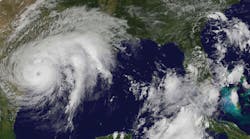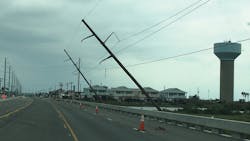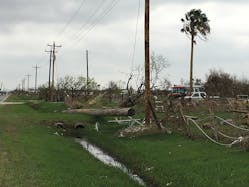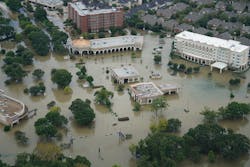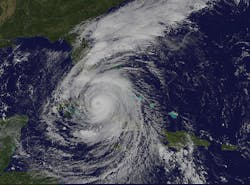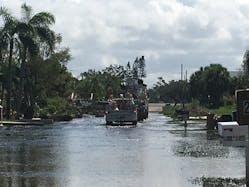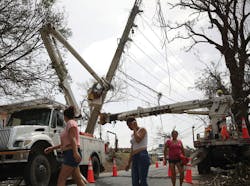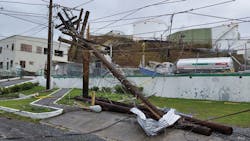No matter what it is called or how it is described, this year’s hurricane season has not been what anyone would consider normal. To the people of the Caribbean, Gulf Coast and East Coast of the United States, monster storms were too many, came too often and were too powerful. Climatological specialists will have a great deal of data to work through, trying to explain what happened and what the future will bring. There has been a lot of discussion about global warming and climate change being the reasons for this extreme weather, but no one knows for sure.
Some experts say this is the new normal, while others say extremely strong hurricanes are nothing new. It is hard to forget storms such as Katrina, Rita and Ike that devastated so many areas. That being said, scientists from the National Oceanic and Atmospheric Administration (NOAA), the National Hurricane Center (NHC) and the National Weather Service (NWS) expressed concern with the 2017 hurricane season and its implications for the coming years.
Before this year’s onslaught of storms, NOAA advised that the 2017 season had the potential to be “extremely active” because of higher ocean temperatures in the Atlantic basin and lower wind shears expected. NOAA also predicted there would be 14 to 19 named hurricanes, of which two to five hurricanes would be major (Category 3 or greater). However, no one had any idea how powerful “extremely active” would mean.
By mid-September 2017, the NHC reported there had been six named tropical storms, one unnamed tropical depression and seven named hurricanes. With the changes tropical storms have brought about, NWS began a new storm surge alert system for 2017. NWS would issue watches and warnings for coastal flooding caused by each storm, no matter the strength. The weather service warned that hazards, like storm surges, can occur even during storms with low wind speeds. Most hurricane causalities come from water in the form of flooding caused by rainfall, waves and storm surges.
Stronger Storms
NOAA’s prediction of an extremely active hurricane season proved more than accurate. Within a period of a little more than three weeks, four major storms had developed. The first was Harvey, a Category 4 hurricane (winds of 130 mph to 156 mph), which set records for devastation, flooding and misery in late August 2017, but that was only the beginning.
As September unfolded, Harvey restoration efforts were in full swing when a bigger monster storm appeared. It was a Category 5 hurricane (winds of 157 mph or higher) named Irma. This, the season’s second major hurricane, was more powerful than the first, setting a record with sustained 185-mph winds for 37 hours. As it crossed the Caribbean, whole islands were decimated, but that was not the end.
While Irma ravaged the Caribbean, the third major hurricane, Jose, entered the area as a Category 4 storm. Jose followed closely behind Irma on much the same path through the Leeward Islands. Fortunately, it stalled in the Bermuda Triangle, giving authorities across the region time to begin the Irma restoration effort. After a week of uncertainty, Jose lumbered up the East Coast with tropical storm warnings as far north as Rhode Island and Massachusetts.
At the same time Irma and Jose were impacting the Caribbean, a fourth hurricane — Category 2 Katia (winds of 96 mph to 110 mph) — was doing damage along Mexico’s Gulf Coast. It came ashore as a Category 1 storm (winds of 75 mph to 95 mph) with heavy rain and flash flooding between Tampico and the city of Veracruz. According to the NHC, this was the first time since 2010 three simultaneous hurricanes were active in the Atlantic basin, but the onslaught still was not over.
As Irma and Katia lost energy, they became rain producers, and the Atlantic basin produced another Category 5 storm, Hurricane Maria. Two weeks from the day Irma hit Puerto Rico, Maria hit the island. This truly had been an active period for hurricanes, and it was only midseason.
A Different Kind of Hurricane
Harvey was the eighth named storm of the 2017 season. It also was the third hurricane and the first major hurricane for 2017. Harvey also holds the distinction of being the wettest hurricane on record in the U.S. Harvey became a Category 3 hurricane (winds of 111 mph to 129 mph) on Aug. 24 and took aim at the Texas Gulf Coast. Unlike typical hurricanes, Harvey intensified right up to the time it came ashore. The extremely warm Gulf waters and moisture-laden atmosphere provided the fuel the storm needed to become a Category 4 hurricane, prior to making landfall on Aug. 25.
In addition, two equal-strength high-pressure systems formed on either side of the advancing hurricane, which played a role in Harvey’s impact on the area. Each of the highs was trying to push Harvey in the opposite direction, which resulted in the hurricane stalling rather than quickly moving inland and out of the area.
The hurricane came ashore just northeast of Corpus Christi, Texas, between Port Aransas and Port O’Connor. Harvey’s eye passed directly over Rockport, Texas, and the damage was extreme, with entire blocks leveled by the hurricane’s winds. Reports estimated nearly every structure in Port Aransas and Rockport sustained some degree of damage, with many buildings a total loss, and the electrical infrastructure took a direct hit. Power outages began as Harvey approached the coast and increased after it made landfall. AEP Texas reported 54 substations and 56 transmission lines were out of service, resulting in approximately 200,000 people without electricity in the area centered around Corpus Christi and the surrounding communities.
Outages spread to Houston, Texas, and beyond as lights began to blink and go out, with the main body of the hurricane reaching the Texas coast. CenterPoint Energy reported more than 49,000 customer (meter) outages, but by evening, the number increased to about 70,000. Guadalupe Valley Electric Corp. reported more than 16,400 customer outages. Entergy Texas also reported more than 30,000 customers without power.
All About the Water
The wind damaged some communities while massive rainfall flooded others. In fact, the day after Harvey became a tropical storm, some areas thought they dodged a bullet only to have overflowing rivers flood their communities. It has been estimated more than 9 trillion gallons of water, or about 50 inches of rain, fell on Houston during the tropical storm, causing extreme flooding. Estimates for the entire region — southeastern Texas and Louisiana — ranged from 19 trillion to 22 trillion gallons. No matter how much rain is attributed to Harvey, the experts agree Harvey’s flooding broke all the models, and they are calling it a 1000-year weather event because of the extent of the flooding and damage it caused.
The combination of flooding and storm surge contributed to another storm-related phenomenon called compound flooding. With rain measured in feet, the rivers were swollen and flowing heavily toward the Gulf. Harvey produced a storm surge of about 3 feet to 9 feet, depending on the location. As storm surges go, this was not very much, but it was moving inland at the same time rain-caused runoff surge was moving down the rivers and streams. When the two surges met, the water piled up and spread out over the lowlands adjacent to these waterways — compound flooding. It also added more customer outages than the initial hurricane itself as water levels rose.
On Aug. 28, Harvey moved back into the Gulf southeast of Port O’Connor and slowly drifted east-southeast, just off the Texas coast. However, the rain continued unabated, adding to the flooding. A few days later, on Aug. 30, Harvey came back on shore near Cameron, Louisiana, and headed north-northeastward. At that point, it finally started moving out of the devastated Gulf Coast area. Harvey’s slow movement from Aug. 25 to Aug. 30 meant the rain continued and the flooding in southeastern Texas and Louisiana reached unparalleled amounts.
A news release from Entergy Texas said, “For six days, Harvey moved at a snail’s pace across the Entergy footprint, dropping more than 30 inches of rain in some areas, flooding neighborhoods and businesses. Entergy wasn’t immune from Harvey’s wrath, as 17 substations and miles of transmission lines were damaged.” At the height of the storm and flooding, customer outages exceeded 311,000. However, the number of people affected by the loss of power ranged in the millions for the entire storm-ravaged area.
A Different Response
Harvey’s flooding limited the ability of utilities to get into storm-damaged areas and impacted restoration plans, but it also was an opportunity for the use of some technologies the utilities had in place to help in situations like this. The utilities had been storm hardening their systems since Hurricane Ike pounded the area. They had replaced wood poles and structures with concrete and composites.
Many of the utilities in the affected area had invested in state-of-the-art equipment — smart meter network, smart switches and other smart devices — linked to sophisticated management systems. These smart grid technologies enabled utilities to respond quickly. The technology also enabled utilities to reroute circuits and reestablish power to customers without sending crews to do the work, which freed up crews for other work.
The use of commercial drones was another technology used by utilities for faster restoration. At first, the U.S. Federal Aviation Administration (FAA) restricted the airspace above the storm-ravaged region, but it did not take long for it to begin issuing exceptions. In the days after Hurricane Harvey, the FAA issued 137 airspace authorizations for commercial drone-related recovery efforts, which allowed specially sanctioned pilots to fly in the restricted airspace. Local authorities, utilities, oil, gas, railroads, the Red Cross and others used drones for flooding assessment.
Many users noted the commercial drones were complementary to helicopters and not competition. The drones freed up the helicopters to do what they do best — search and rescue work. Commercial drones proved valuable by being cost effective, being able to fly lower and not risking pilots’ lives in close congested neighborhoods.
Several utilities reported drones opened inaccessible areas and provided high-resolution imagery in real time. This helped them to assess damage and deploy the right resources in the right places for power restoration. Utilities needed every advantage available to battle the aftermath of Harvey, but, as restoration efforts progressed, they faced a new challenge on another part of the electrical grid.
Cascading Catastrophes
On Aug. 31, as Harvey was moving out of the Texas-Louisiana Gulf Coast region, a Category 2 hurricane developed, named Irma, the ninth named storm of the hurricane season. By Sept. 5, it intensified to a brutal Category 5 storm with winds of 175 mph, which increased to 185 mph the next day and headed toward the Caribbean. On Sept. 6, Irma became a Category 5 hurricane, striking the Leeward Islands. It made successive landfalls in St. Martin, Ginger Island, the British Virgin Islands, Anguilla, Barbuda and others. The islands of St. Barthelemy, St. Martin/St. Maarten and Barbuda were damaged heavily with their electric power systems demolished.
After the storm, the residents of Barbuda were evacuated to Antigua, and for the first time in 300 years, the island was uninhabited. Additionally, the U.S. Virgin Islands, Puerto Rico, Cuba, parts of Hispaniola and Florida were directly in the storm’s path. The U.S. Department of Energy (DOE) reported the U.S. Virgin Islands’ two islands — St. John and St. Thomas — share a common power grid. The hurricane knocked the interisland power grid out completely, and 100%, or more than 22,000, of the customers on the two islands were without power.
The DOE also reported St. Croix fared a little better as more than 41%, or 9000 customers, were without power. Puerto Rico received substantial damage to its electrical infrastructure. After the hurricane moved on, more than 66%, or 1 million, customers were in the dark. Cuba was the next island to be hit by the storm. Irma caused extensive damage to the power grid along the northern coast and several electrical plants in the region.
Rebuilding the electric grid of each of these islands will be challenging. In many cases, Irma’s high winds and flooding removed everything in its path, so restoration will require total rebuilding and storm hardening, unlike previous restorations. Irma’s next target was Florida.
Path of Destruction
After wreaking havoc in the Caribbean, Irma made two landfalls in Florida. The first came on the morning of Sept. 10. Irma came ashore as a Category 4 storm in the lower Florida Keys, continuing its island destruction as it had in the Caribbean. Many of the Keys experienced extensive damage to buildings from high winds and storm surge of an estimated 10 feet. After crossing the Keys, it made its second landfall later in the day as a Category 3 hurricane. It came ashore on the west side of Florida at Marco Island, south of Naples, where winds were measured at 142 mph just prior to the landfall.
Once on land, Irma lessened to a Category 2 hurricane as it moved inland. By the time it reached Tampa, it was a Category 1 storm in strength, but there is no such thing as a weak hurricane. Irma’s 400-mile-diameter body covered Florida’s west and east coasts, and stretched along the peninsula with high winds, rainfall and flooding.
The eastern side of the state may have missed the direct hit from Irma, but the hurricane produced disastrous results with high winds, excessive rain and storm surges. The high winds sent trees toppling into T&D lines. The flooding wreaked havoc on the distribution systems across the state and outages increased as the storm moved forward. Around Miami-Dade and Broward counties, several construction cranes collapsed on buildings from the high winds, and distribution circuits were destroyed by downed trees and flooding.
Florida Power & Light (FPL) reported 263 substations were damaged by Irma. Florida’s Division of Emergency Management reported Irma left 6.7 million customers without electricity. According to the U.S. Department of Homeland Security, this equated to about 15 million Floridians, or about 75% of the state’s population.
Flooding extended as far north as Jacksonville, but the damage from Hurricane Irma was not limited to Florida. It also knocked out power to about 1.3 million customers in Georgia, more than 208,000 customers in South Carolina, nearly 320,000 customers in North Carolina and around 45,000 in Alabama.
Utilities across the region activated the nationwide mutual assistance network for help to restore their power grids. According to the DOE, this was one of the largest undertakings in U.S. history, involving 49 states and Canada. Utilities set up staging areas throughout their service territories to house mutual assistance crews, contractors, and other support personnel and responders.
Edison Electric Institute President Tom Kuhn said, "Mutual assistance is a hallmark of our industry, and serves as an effective and critical restoration resource for electric companies." Kuhn also reported, "An army of more than 50,000 workers from across the U.S. and Canada is now dedicated to supporting the industry’s Irma restoration efforts."
Technology in Action
The utilities in Florida have been storm hardening their systems since Hurricane Wilma in 2005 and it paid off. FPL, Duke Energy Florida, Tampa Electric and others made significant investments to improve their hurricane preparedness since that wake-up call. They replaced wood utility poles with concrete and composite poles. They buried power lines underground in cities willing to pay the cost. They also deployed smart grid technologies, added pumps to substations and spent substantial amounts on vegetation management.
FPL also installed real-time water monitors at 223 substations most susceptible to storm surges throughout its service area. These monitors did not prevent flooding during Irma, but they provided advanced warnings that enabled FPL to shut down a substation proactively before the equipment was severely damaged by water.
FPL President Eric Silagy said, “Frankly, those flood monitors saved three or four days of work and millions of dollars’ worth of equipment that would have had to be replaced rather than simply reenergized.”
The technologies proved to be invaluable for quickly restoring power to all areas hard hit by Harvey and Irma, but Jose and Maria continued to pound the Caribbean, and the next landfalls were on everyone’s mind. Many crews supporting restoration efforts moved directly from Harvey to Irma restoration. They wondered if they would be saddling up again for yet another round of restoration.
Also, as with the Harvey restoration, drones played a key role in recovery. Shortly after Irma, the FAA issued 132 airspace authorizations in Florida. According to the Wall Street Journal, these approvals were processed within hours of filing, which is an exceptionally fast turnaround for the government. Hundreds of commercial drone flights took place in Harvey- and Irma-devastated areas for the restoration efforts. One FAA official said he thought this was a landmark in the evolution of drone use for hurricane response.
Maria Knocks Out Power
Two weeks after Irma hammered Puerto Rico and the U.S. Virgin Islands, Hurricane Maria battered the region again. On Sept. 19, the Puerto Rico Electric Power Authority (PREPA) reported it had restored power to all but 3.9% of customers, or 61,308, from Irma-caused outages. The next day, the eye of Category 4 Hurricane Maria ripped through Puerto Rico. PREPA reported the loss of its entire power grid, and there was no neighboring utility to help with crews or power. It was estimated PREPA lost 55% of its transmission and about 90% of its distribution network.
The DOE said nearly 1.57 million electric customers in Puerto Rico were without electricity. An electricity transmission assessment team from New York flew into San Juan to survey the damage using helicopters and drones. Initial reports indicate a complete rebuild will be needed to get power back on for the island. Six weeks after Maria struck Puerto Rico, PREPA asked for U.S. mainland utilities to help restore power. According to the DOE, this is the longest power outage in the history of the U.S.
As of Nov. 1, 2017, the U.S. Corps of Engineers reported that power has been restored to approximately 30% of the island’s 1.5 million homes.
On the U.S. Virgin Islands, St. Croix had missed the full force of Irma, but this time, the island was in the path of Maria. The DOE reported the majority of the 25,000 customers on St. Croix were without power. The only electricity available was from generators. The islands of St. Thomas and St. John had been making progress restoring customers from Irma outages, but they lost ground when Maria slammed them. The governor of the U.S. Virgin Islands, Kenneth Mapp, said their entire T&D system was down or damaged, and estimated power restoration and recovery will take months.
Superstorms
The 2017 hurricane season has been a nightmare, setting the worst kind of records. Hurricanes Harvey, Irma and Maria had a devastating effect wherever they trekked. They damaged the infrastructure, knocked out the electrical power grid, and left millions of people without homes or basic necessities.
Harvey, Irma and Maria have been declared the most destructive hurricanes ever experienced, with damage cost estimates running in the hundreds of billions of dollars. The big question is, what comes next? ♦
